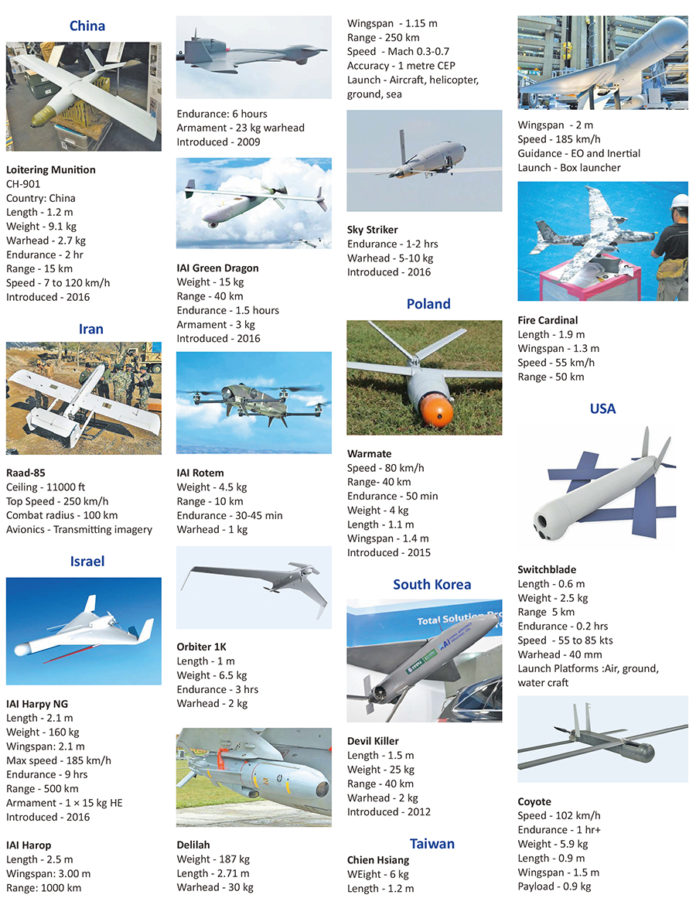The Ministry of Defence (MoD) issued a request for information (RFI) to procure 100 loitering munition systems for the Indian Army on 6 March.
The RFI says it wants a loiter munition that is man-portable, weigh less than 20kg, flight endurance of at least 30 minutes, range of 15 km (Line of Sight), ability to operate upto an altitude of 4500m (above mean sea level) and not less than 300 metres (above ground level), possess anti-jamming and anti-spoofing properties, carry warhead to destroy personnel and soft-skinned targets which have little or no armor. The loiter munition should also be controlled by a ground controller with a data link established with the loiter munition system.
The vendor is to provide one loiter munition with complete set of sensor package mounted on the loiter munition system (with day and night capability) along with one ground control station to include ruggedized handheld display, communication system, antenna and tripod. The ground control station should be able to control multiple loiter munitions. It should be able to be air dropped placed on a platform system and flexible enough to slither down man packed from helicopters.
The ministry expects the delivery of almost all of the loitering munition systems within 18 months from the date of signing of the contract.
In late January 2020, Israeli firm UVision Air announced a joint venture named “AVision” with India’s Aditya Precitech to manufacture loitering munitions under the brand PALM (Precision Attack Loitering Munition) Hero Systems.
Typical Loitering Munition
A loitering munition is a type of unmanned aerial vehicle designed to engage beyond line-of-sight ground targets with an explosive warhead.
Once launched, loiter munition can ‘loiter’ in the air and wait for its target, or conduct reconnaissance and surveillance operations. It then launches a ‘suicide attack’ like a missile after finding out its location. Some types of loitering munitions can even return to the base for future deployment.
Historical Context
In the early history of unmanned aviation, the distinction between a drone and guided missile was not always well defined. The World War I-era Kettering Bug, regarded to be one of the first drones, was designed to deliver an explosive charge by crashing into its targets, more like a rocket than the reconnaissance and strike aircraft that we associate with the word “drone” today. But now an emerging field of unmanned aircraft, called loitering munitions, once again blurs the line between drone and missile.
Loitering munitions are often portable and many are meant to provide ground units such as infantry with a guided precision munition. They are equipped with high resolution electro-optical and infrared cameras that enable the targeter to locate, observe, and guide the vehicle to the target. A defining characteristic of loitering munitions is the ability to “loiter” in the air for an extended period of time before striking, giving the observer time to decide when and what to strike.
Early loitering munitions like the Israel Aerospace Industries Harpy, which was unveiled in the early 1990s, were intended to be used against radar installations or mobile missile launchers. Today, many loitering munitions are marketed for infantry use because they offer ground forces greater precision than, for example, a mortar. Unlike other types of drones of equivalent size and weight, a loitering munition is not meant to be recovered after the mission is over. Once armed and airborne, loitering munitions- which are also known as “suicide drones”-are meant to detonate on impact.
A growing number of countries are acquiring their own loitering munitions, which offer a unique set of new capabilities compared to traditional alternatives such as rockets and mortars. This document provides an overview of loitering munitions currently in use or development, and examines some unanswered questions relating to the potential benefits and dangers of the proliferation of this technology.
Research Initiatives
There is growing concern within the U.S. military that the prominent unmanned aircraft of today-namely the Predator and the Reaper-are not suited for conflicts in contested airspace. These aircraft are slow and unwieldy, making them easy targets for air defenses. As such, the future of unmanned aircraft may be more in the realm of small, attrition drones that can be controlled independently or act autonomously in swarms.
Several U.S. defence programs are developing technologies for large swarms of drones equipped with a range of different payloads that can carry out a variety of missions, including lethal strikes. Some of these programs employ loitering munitions, like the AeroVironment Switchblade or Raytheon Coyote. In the future, drones similar to the loitering munitions featured in this guide could come to dominate the airspace far more than any single drone does today.
Opportunities and Potential Benefits
Use of loitering munitions could enable increased capacity to discriminate between combatants and noncombatants compared to equivalent weapons such as mortars, rockets, and small missiles. The loiter capability of these systems allows users to detect and track potential targets for extended periods of time before a strike.
Loitering munitions could enable improved precision compared to equivalent weapons. For example, the AeroVironment Switchblade creates a forward-facing blast that makes the detonation more targeted than a grenade, which creates a 360-degree blast. Loitering munitions are steerable, whereas many equivalent munitions are not. Loitering munitions may be cheaper than some guided missiles that provide a similar level of precision. The AeroVironment Switchblade, for example, is estimated to cost around $70,000 a piece, roughly two-thirds the cost of the AGM-114 Hellfire, a missile used on several strike drones and gunships.
Various loitering munition models feature a “wave off” feature that allows operators to cancel an attack in mid-flight and ditch the aircraft harmlessly. Traditional rockets, mortars, and missiles do not have this feature.
====================


















